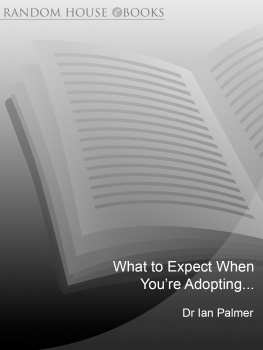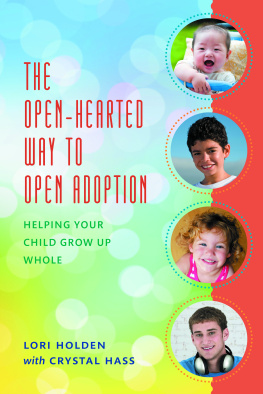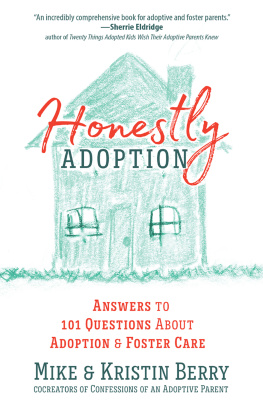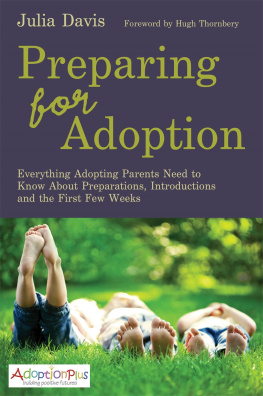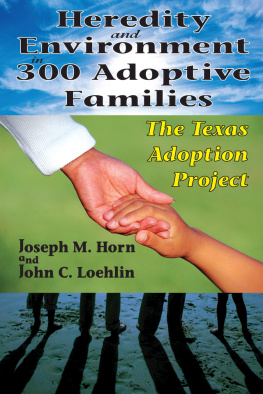Making
Sense of
Adoption

A Parents Guide

Lois Ruskai Melina

To Carl,
my partner in parenting
Children are most like us in their feelings and least like us in their thinking.
David Elkind
in Children and Adolescents
Contents
I was having dinner out with my children, who are both Asian-American. At a nearby table were three Asian-American women. My son, then three, pointed at the women and commented on their appearance. Before I could respond to him, my daughter, who was six, urgently whispered to him, Be quiet. One of them could be your mother.
I knew then that my daughter was thinking about adoption and about her birthmother more frequently and with more depth than I was aware of.
This surprised me because she seemed to feel comfortable talking about adoption with me. She seemed willing to ask questions, and I thought I had let her know by my general responsiveness that we could talk about anything related to her adoption or her birthparents. And because Im involved with adoption professionally, I thought I was, if anything, over-sensitive to any signs that she was dealing with an adoption issue.
For the first time, I realized that while we discussed adoption easily, she didnt share all her thoughts with me. And I knew that her thoughts at the age of six were only the beginning of years of questioning and increasing awareness about adoption and its importance in her life.
Shortly after that incident I began traveling throughout the country speaking to adoption groups about raising adopted children. Everywhere I went I found adoptive parents who want to help their children make sense of adoption in a way that leaves the children feeling self-assured and loved. Some were parents of infants and were anticipating the different concerns their children would have as they grew up. Others had already been asked specific questions by their preschoolers, school-age children, or adolescents.
This book, then, grew out of current child development theory and modern adoption philosophy, and out of the many conversations I have had with adoptive parents, adoptees, and birthparents.
It will help adoptive parents understand the kinds of concerns children have about themselves and their origins at each stage of growth so parents can provide the answers children need, even if the questions are not asked directly. Sample conversations and examples will help alert parents to subtle signs that their children could be grappling with adoption issues so accurate and age-appropriate information can be provided in a loving and empathetic way.
The information we provide our children affects them emotionally. Adoptive parents should be prepared not only for the questions their children will have, but for the reactions their children may have to the answers to those questions. Help in preparing for this role is offered later in this chapter.
This book is for those parents who made a decision to become the legal parents of a child genetically unrelated to them, regardless of whether legal action was necessary for them to do so. It is for families who meet the dictionarys definition of adoption-to take and treat as ones own-regardless of whether they meet a courts definition.
This definition includes children adopted by stepparents; those conceived through donor insemination, in vitro fertilization with a donor egg or embryo, and surrogacy; as well as those who meet the traditional definition of adoption. (We sometimes distinguish between those adoptions in which birthparents and adoptive parents are not given the opportunity to share information or have ongoing contact and those in which information is shared and ongoing contact provided for by calling the former traditional adoptions and the latter open adoptions. In this book, however, the term traditional adoption refers to the common practice of adoption-whether open or not-in which a child is legally adopted by one or two biologically unrelated parents, to distinguish it from adoption through donor insemination, surrogacy, and in vitro fertilization.)
Regardless of how children are adopted, they share important issues. For the preschooler, the question, Where did I come from? is more complex, either because of the method of conception or the childs journey to a new family after birth. School-age children wonder why they were adopted when most people arent, and how their value as a person is affected by the different way they joined their families. Adolescents struggle to know who they are in a very basic sense-a question that is more difficult when they are missing information about their biologic parents.
Most importantly, adopted children are likely to grieve for the loss of their birthparents. This is not necessarily the same kind of grief they would feel if they suddenly lost the parents they had lived with for many years. Its a grief that comes from knowing they have lost people who played a significant role in their lives.
Even children who have regular contact with their birthparents, such as those in an open adoption, have lost their birthparents as parents, and may still have questions about why their birthparents didnt keep them and what it means to be adopted.
While adopted children share many issues, they also have issues unique to the particular way they joined their families. For example, children adopted through donor insemination, surrogacy, and in vitro fertilization with a donor egg or donor embryo were deliberately created by a parent intending to terminate his or her parental rights. In some cases, large sums of money were connected to the adoption. Other children had birthparents whose parental rights were taken away from them.
Parents who have adopted through donor insemination, surrogacy, and in vitro fertilization are just beginning to look toward the traditional adoption community for guidance in helping their children deal with these many issues because the importance of openness has been accepted in traditional adoptions for much longer. This book, however, goes beyond the standard advice given to adoptive families for many years-to tell their children early that they are adopted-and describes how childrens awareness of adoption changes with their growth and suggests how parents can meet the challenges this poses in their families.
Some time ago I was asked to write an essay on the rights of adopted children for the alternative parenting journal Nurturing Today (187 Caselli Ave., San Francisco, Calif. 94114). It was a topic I hadnt given much thought to. As I researched the article and examined my own thoughts on the subject, I came to the conclusion that children arent accorded many rights at all. And those that they are given are subject to interpretation if they conflict with the rights of others. For example, childrens right to a good education may conflict with the right of citizens not to be taxed excessively. And even when there is general agreement on childrens rights, society is reluctant to impose its values on families who do not agree. For example, behavior that many people would consider child abuse is considered acceptable discipline by others.
So while I believe that adopted children have certain rights, these are not guaranteed by law. They can only be accorded to children if we are committed to the principles behind them:
Next page

